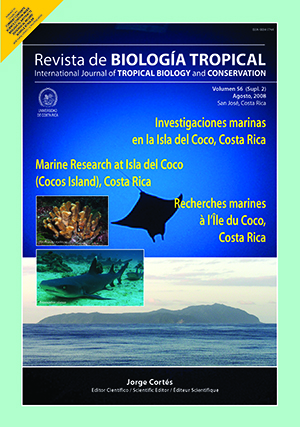Resumen
La literatura publicada sobre Isla del Coco, Costa Rica demuestra que los octocorales están dentro de los grupos de invertebrados marinos menos conocidos. Dentro de la subclase Octocorallia hay tres órdenes de las cuales dos se encuentran en la Isla del Coco: Pennatulacea (plumas de mar) y Alcyonacea (corales suaves, gorgonias y teléstidos). Con información obtenida de investigaciones y recolecciones recientes, la fauna de octocorales de la Isla del Coco incluye actualmente tres penatulaceos, ocho gorgonias, un coral suave y un teléstido. De estos, un penatulaceo, un teléstido y tres gorgonias han sido recolectados recientemente, y dos de ellos son, probablemente, especies nuevas. En el género Pacifigorgia hay una especie: P. curta, que hasta el momento se considera endémica. Hay dos especies en el género Leptogorgia, una que tiene un amplio ámbito de distribución a lo largo de la costa pacífica de Costa Rica, L. alba, y otra que es una especie nueva que solo se ha encontrado en la Isla del Coco y está siendo estudiada. Finalmente, se ha encontrado una especie sin describir, relacionada con el género Rhodelinda que aparece adherida a rodolitos. Las otras especies que se citan en la literatura, la gorgonia, Psammogorgia variabilis, y el penatulaceo, Ptilosarcus undulatus, necesitan ser corroboradas ya que no han sido vistas ni recolectadas todavía. Otras especies, incluyendo alcionias (corales suaves), han sido observadas de 50 m a 450 m de profundidad por medio de inmersiones en submarinos y algunas muestras fueron recolectadas durante un crucero del Instituto Oceanográfico de Harbor Branch en 1986 con el sumergible Jonson Sea Link hasta unos 700 m de profundidad. De estas se han identificado cuatro géneros, dentro de los cuales se espera que se incluyan algunas especies nuevas para la ciencia.Citas
Bakus, G.J. 1975. Marine zonation and ecology of Cocos Island, off Central America. Atoll Res. Bull.179: 1-11.
Bayer, F.M. 1981. Status of Knowledge of Octocorals of World Seas. Seminários de Biologia Marinha, Academia Brasileira de Ciências, Rio de Janeiro 1-102 pp.
Beebe, W. 1926. The Arcturus Adventure: An Account of the New York Zoological Society’s First Oceanographic Expedition. G.P. Putman, New York. 439 p.
Breedy, O. & H.M. Guzman. 2003. The genus Pacifigorgia (Octocorallia: Gorgonacea) in Costa Rica (Coelenterata: Octocorallia: Gorgoniidae). Zootaxa 281: 1-60.
Breedy, O. & H.M. Guzman. 2005. A new species of alcyonacean octocoral from the Galapágos Archipelago. J. Mar. Biol. Assoc. U.K. 85: 801-807.
Breedy, O. & H.M. Guzman. 2007. A revision of the genus Leptogorgia Milne Edwards & Haime, 1857 (Coelenterata: Octocorallia: Gorgoniidae) in the eastern Pacific. Zootaxa 1407: 1-90.
Breedy, O., C.P. Hickman & G.C. Williams. 2008. Octocoral research in the Galapagos Islands. Galapagos Res. J.: in press.
Cortés, J. 1996-1997. Biodiversidad marina de Costa Rica: Filo Cnidaria. Rev. Biol. Trop. 44/45: 323-334.
Cortés, J. 2008. Historia de la investigación marina de la Isla del Coco, Costa Rica. Rev. Biol. Trop. 56 (Supl. 2): 1-18.
Cortés, J. & S. Blum. 2008. Life down to 450 m at Isla del Coco, Costa Rica. Rev. Biol. Trop. 56 (Supl. 2): 189-206.
Daly, M., M. Brugler, P. Cartwright, A.G. Collins, M.N. Dawson, D.G. Fautin, S.C. France, C.S. McFadden, D.M. Opresko, E. Rodriguez, S.L. Romano & J.L. Stake. 2007. The phylum Cnidaria: A review of phylogenetic patterns and diversity 300 years after Linnaeus. Zootaxa 1668: 127-182.
Deichmann, E. 1941. Coelenterates collected on the Presidential Cruise of 1938. Smithsonian Misc. Collec. 99 (10): 1-17.
Jeyasuria, P. & J.C. Lewis. 1987. Mechanical properties of the axial skeleton in gorgonians. Coral Reefs 5: 213-219.
Fabricius, K. & P. Alderslade. 2000. Soft Corals and Sea Fans: A Comprehensive Guide to the Tropical Shallow Water Genera of the Central-West Pacific, the Indian Ocean and the Red Sea. Australian Institute of Marine Sciences, Townsville, Australia. 264 p.
Quammen, D. 1996. The Song of the Dodo: Island Biogeography in an Age of Extinctions. Simon and Schuster, New York. 702 p.
Sadler, J.P. 1999. Biodiversity on oceanic islands:a palaeoecological assessment. J. Biogeogr. 26: 75–87.
Studer, T. 1894. Note préliminaire sur les alcyonaires. Reports on the dredging operations carried on by the U.S. Fish Commission Steamer «Albatross», during 1891. Bull. Mus. Comp. Zöol. 25: 53-69.
Williams, G.C. 1990. The Pennatulacea of southern Africa (Coelenterata, Anthozoa). Ann. South African Mus. 99: 31-119.
Williams, G.C. 1992. Biogeography of the octocorallian coelenterate fauna of southern Africa. Biol. J. Linnean Soc. 46: 351-401.
Williams, G.C. 1993. Coral reef octocorals - an illustrated guide to the soft corals, sea fans and sea pens inhabiting the coral reefs of northern Natal. Durban Natur. Sci. Mus. 64 p.
Williams, G.C. & O. Breedy. 2004. The Panamic genus Pacifigorgia (Octocorallia: Gorgoniidae) in the Galápagos Archipelago. Proc. California Acad. Sci. 55: 54-87.
##plugins.facebook.comentarios##

Esta obra está bajo una licencia internacional Creative Commons Atribución 4.0.
Derechos de autor 2008 Revista de Biología Tropical


